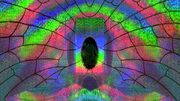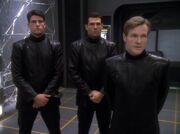Renegade54 (talk | contribs) m (formatting, linkfix) |
No edit summary |
||
| Line 23: | Line 23: | ||
Among the viewing modes on a holodeck is objective mode, in which the user doesn't interact with the characters, and subjective mode, in which the viewer can interact with the characters as well as alter his or her surroundings. ([[ENT]]: "[[These Are the Voyages...]]") |
Among the viewing modes on a holodeck is objective mode, in which the user doesn't interact with the characters, and subjective mode, in which the viewer can interact with the characters as well as alter his or her surroundings. ([[ENT]]: "[[These Are the Voyages...]]") |
||
| + | |||
| + | :''There are many discrepencies between episodes of the abilities and limits of holodeck technology. In [[Elementary, Dear Data]], a piece of paper given to [[Data]] by [[James Moriarty]] is able to be carried outside of the holodeck and into the hall, but upon Moriarty's return in [[Ship in a Bottle]], a book thrown outside of the holodeck instantly disappears. Also, in [[The Big Goodbye]], [[Redblock]] and [[Leech]] disappear slowly after a few moments outside of the holodeck. Although these inconsistencies can be partially explained by the difference in the types of objects leaving the holodeck, it still leaves quite a few questions about what exactly constitutes the differences.'' |
||
==Early holodeck technology== |
==Early holodeck technology== |
||
Revision as of 22:52, 27 June 2006
An inactive holodeck
A holodeck is a room equipped with a hologrid containing omnidirectional holographic diodes, enabling holographic projections.
Purpose & Design
The holodeck serves both entertainment and training purposes. It combines transporter technology with that of replicators, by generating holographic images in 3D space as well as projecting force fields to give the objects the illusion of substance. It can be controlled from an exterior control or the interior arch control. This arch can be summoned at any time to change the parameters of a running holoprogram.
Holodeck walls can generate holographic images that appear to extend for an unlimited distance, seemingly much larger than its own dimensions. In doing so, however, the holodeck is aware only of its users; it does not recognize its own created objects. For example, if a person were to throw a holographic rock at the holodeck's walls, the rock would not be allowed to pass beyond the wall. (TNG: "Encounter at Farpoint"). It does this by continuously adjusting the projections of the force fields and the use of a force field "treadmill". With this, an individual approaching a wall causes an instant shift away. The holodeck can change gravity in three dimensions, so occupants don't notice the change. (Star Trek: The Next Generation Interactive Technical Manual)
An inactive Cardassian holodeck
Holodeck matter can impersonate real matter even at the molecular level. (VOY: "Phage") Molecule-sized magnetic bubbles replace molecules in full- resolution holo-objects. The computer can manipulate them individually in three dimensions. The computer may use large magnetic bubbles to simulate surfaces and textures rather than create an object at the molecular level. However, Objects created within the holodeck could not exist beyond the holodeck itself, as they only exist as energy and matter. (TNG: "The Big Goodbye")
A holodeck can modify the appearance of the persons in it. In Tom Paris' holoprogram "Captain Proton", everything and everyone can only be seen black and white. Seven of Nine used the holodeck to hide her cybernetic implants (VOY: "Human Error"). However, it is unclear if this illusion works for Humans, because the only "persons" attending the program were Seven herself and the Doctor, who is holographic.
Holograms can also be projected into space. They can be augmented with force beams to simulate solid, tangible objects or with replicator technology to create actual solid matter such as foodstuffs. All foods eaten on the holodeck are replications. No other type of simulation would survive outside of the holodeck.
A holodeck also has the ability to create holodecks within holodecks, and holodeck programs are able to be saved to a cube that can be inserted into special devices with information to "last a lifetime". (TNG: "Ship in a Bottle")
Computers cannot duplicate the complexity of electron shell activity and atomic motions that determine biochemical activity in living creatures. This prevents replicators from duplicating life and resurrecting the dead. Advances in computer technology may allow this, permitting a person to live forever in any chosen environment while interacting with real people and objects visiting the holodeck.
The energy matrix of a holodeck is incompatible with other ship systems.
Failure of a holodeck's matter conversion subsystem can cause the loss of solid objects within the holodeck environment. Materialization errors occurred in the Enterprise-D holodecks in 2370 following the ship's exposure to plasmonic energy in the atmosphere of planet Boraal II. (TNG: "Homeward")
Among the viewing modes on a holodeck is objective mode, in which the user doesn't interact with the characters, and subjective mode, in which the viewer can interact with the characters as well as alter his or her surroundings. (ENT: "These Are the Voyages...")
- There are many discrepencies between episodes of the abilities and limits of holodeck technology. In Elementary, Dear Data, a piece of paper given to Data by James Moriarty is able to be carried outside of the holodeck and into the hall, but upon Moriarty's return in Ship in a Bottle, a book thrown outside of the holodeck instantly disappears. Also, in The Big Goodbye, Redblock and Leech disappear slowly after a few moments outside of the holodeck. Although these inconsistencies can be partially explained by the difference in the types of objects leaving the holodeck, it still leaves quite a few questions about what exactly constitutes the differences.
Early holodeck technology

A 22nd century Xyrillian holo-chamber
Prior to the late 24th century, Federation starships were not equipped with holodecks. (VOY: "Flashback") However, in 2151, the Earth Starfleet spacecraft NX-01 Enterprise encountered a vessel belonging to an alien race known as Xyrillians, who had advanced holographic technology in the form of a holographic chamber similar to the holodeck, which Federation Starfleet would develop two centuries later. A holo-chamber was later installed aboard a Klingon battle cruiser, given to the Klingons by the Xyrillians in exchange for their lives. (ENT: "Unexpected")
In the 23rd century, Constitution-class starships were equipped with a recreation room, which employed holographic technology. The USS Enterprise had a recreation room located in Area 39 of the ship. (TAS: "The Practical Joker")
Ferengi entrepreneur Plegg is credited with the development and introduction of the holosuite, a holographic chamber designed for use by one occupant at a time. (DS9: "The Alternate")
Federation holodecks

Luther Sloan and two operatives in a Section 31 holodeck
By 2364, the Federation Starfleet had begun installing holodecks aboard their vessels. (TNG: "Encounter at Farpoint")
Federation holodecks are equipped with safety protocols to prevent serious injury during their use, although these can be disengaged by the user when required. If a forcefield would cause a certain level of physical harm to a living person that field collapses, allowing the person to escape uninjured.
How the security protocols are circumvented differs. In one instance, it required the voice authorization of two senior officers (TNG: "Descent, Part I"). In other instances, the authorization of the individual who started the program is enough. (Star Trek: Voyager)
Holodecks employ spatial orientation systems to simulate parts of a holocharacter, such as left- or right-handedness. (TNG: "Ship in a Bottle")
Holodeck characters have been known to include a program element designed to hide anachronisms to the program's time period, such as uniforms and communicators, and prevent them from raising the character's ire.
During the 2360s and 2370s, a starship could have one or more holodecks depending on the vessel's size. Nova-class starships, for example, did not have a holodeck, while Galaxy-class vessels had five. The two holodecks of Intrepid-class starships are the only places where the EMH can exist (without a mobile emitter) apart from the sickbay. In Prometheus-class starships, the EMH can move more freely because all decks are equipped with holoemitters (VOY: "Message in a Bottle").
Holoprograms
Starships with a holodeck normally had a vast list of holoprograms in its computer. Several notable programs aboard the USS Enterprise-D included:
- A recreation of the voyage on the Orient Express. (TNG: "Emergence")
- Prospero's island, decor for Shakespeare's "The Tempest". (TNG: "Emergence")
- Café des Artistes: "Enjoy a meal at a French cafe."
- Champs Elysees: "Famous section of Paris."
- Charnock's Comedy Cabaret: "Laugh in a 20th century comedy club."
- The Big Good-Bye: "The 1940's world of gumshoe detective Dixon Hill."
- Emerald Wading Pool: "From planet Sumiko III, a safe experience."
- Equestrian Adventure: "Horse riding in an open country..."
- The first appearance of a holodeck was in TNG: "Encounter at Farpoint", although a similar room was seen earlier in TAS: "The Practical Joker".
Notable programs aboard the USS Enterprise-E included: (Star Trek: First Contact)
- The Big Good-Bye: "The 1940's world of gumshoe detective Dixon Hill."
Notable programs aboard the USS Voyager included:
- The Adventures of Flotter (VOY: "Once Upon a Time")
- The Adventures of Captain Proton (VOY: "Night")
- Fair Haven (VOY: "Fair Haven")
